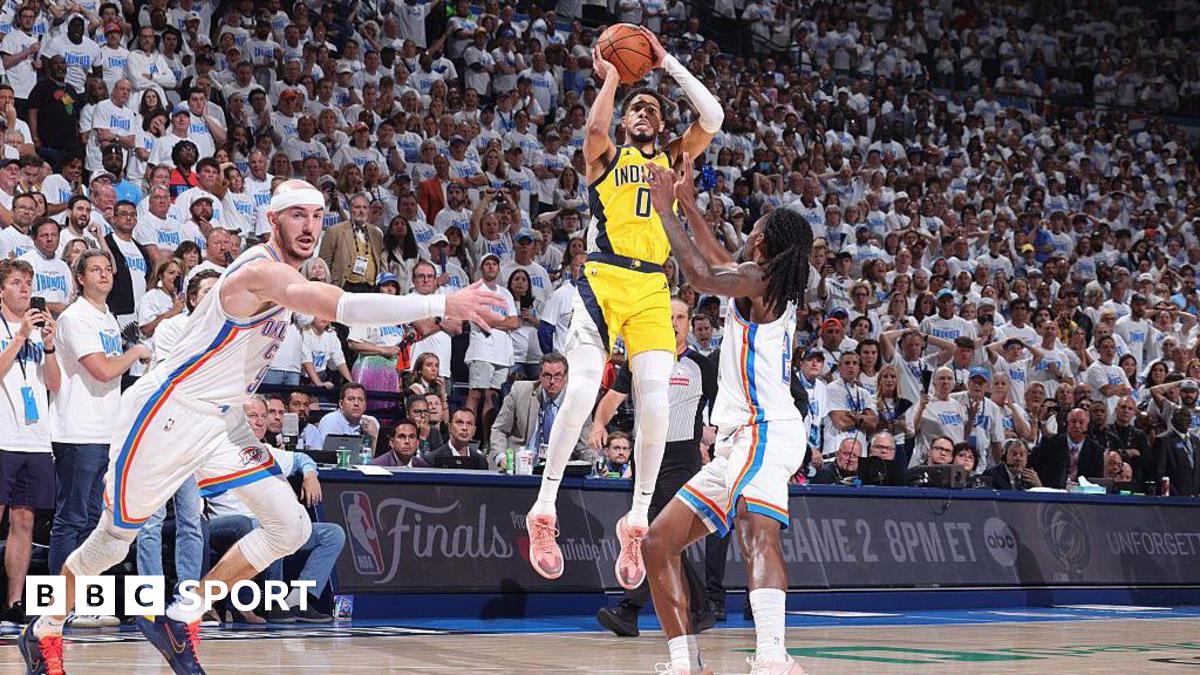Indiana
Proposal would double size of Charles C. Deam Wilderness area in Hoosier National Forest
Indiana’s only federally protected wilderness, already one of the largest and most unique natural areas in the Midwest to earn the designation, could more than double in size under new legislation now before the U.S. Senate’s Committee on Agriculture, Nutrition and Forestry.
The bill would expand the Charles C. Deam Wilderness in Monroe and Brown counties to about 28,000 acres, and designate another roughly 30,000 acres of adjacent land for a proposed National Recreation Area. Indiana Senator Mike Braun is sponsoring the legislation.
Braun and his team did not respond to multiple IndyStar requests for an interview about the proposal.
The Deam wilderness currently spans 13,000 acres of hardwood forests legally preserved under 1964’s Wilderness Act, which requires land managers to maintain the area’s unimpaired natural condition. Braun’s bill would protect another 15,000 acres.
The federal designation prohibits logging, road construction and other development on public land and is intended to “let nature be nature,” according to Jeff Stant, executive director of the Indiana Forest Alliance.
Stant said he’s been talking with Braun since 2013 in a push to get more of the state’s forests set aside and protected from logging efforts.
The conversations eventually culminated in Braun’s recent bill in the U.S. Senate: the Benjamin Harrison National Recreation Area and Wilderness Establishment Act of 2023.
Braun’s proposal is not a done deal. The legislation still needs a House sponsor and would have to clear both chambers of Congress and be signed off on by the president to become law.
For now, United States Forest Service spokesperson Marion Mason said the agency has not taken an official position on the proposed bill because it’s “too early in the process.”
Who was Charles C. Deam?
Charles C. Deam was born a Hoosier and grew up in Bluffton in the second half of the 19th Century. Deam eventually started a drugstore in his hometown and would beat the stress of work by taking nature walks and collecting plants. This led to a passion for botany that opened a path for Deam to become Indiana’s first state forester.
The wilderness area is named in honor of Deam’s legacy in botany and love of nature and ties directly to his work getting the Forest Classification Act established in 1921. The act established a framework to help keep the state’s private forests intact.
The current boundaries of the Deam wilderness, which is within the the Hoosier National Forest, begin immediately south of the eastern edge of Monroe Reservoir. It’s a mostly contiguous area that stretches south and includes portions of Monroe and Brown.
The expansion under Braun’s proposal would be highly segmented, adding new land mostly to the north and east of the current boundaries. A small portion of land north of the reservoir along Axsom Branch Road would also be set aside.
A swath of land to the east of the Axsom Road section, which is owned by the U.S. Army Crops of Engineers, would be excluded from the surrounding wilderness designation. At the eastern edge of the Corps’ land, the wilderness would begin again and extend to near the town of Story. The wilderness would then encompass most of the area south until County Road 1000.
Private landowners in Indiana’s wilderness
Stant said he spent a good deal of time working with landowners in the area because he knew there would be opposition if the federal government used eminent domain to create the expanded wilderness and recreation area.
“I had gone all around and talked to them,” Stant said. “Their attitudes were very much, ‘Yeah, if you can keep the federal government out of there, let’s preserve this.’ There was a unanimous amount of support.”
After working with landowners and bringing those private property concerns back to Braun’s team, the senator assured Stant the area should be protected as wilderness.
Janet Selby’s family has owned property near the Deam wilderness for 56 years.
On a crisp fall day in October, Janet along with her two sisters, Susan and Martha, were at the property fixing up a window that needed repair. The family makes trips to the property as often as possible to enjoy the solitude and beauty of undisturbed forest.
Janet recalled that when Deam was initially established in 1982, private property owners were questioning the federal takeover of their lands.
“A lot of neighbors were opposed to that,” Selby said. “In a compromise, they took out a lot of that and in the new bill with Braun, there’s no private property taken, none. That’s one of the good things.”
While Selby said she wished the wilderness bill protected more areas from logging, she’s very happy with the proposed expansion.
“The wilderness is going to protect and maintain current hiking and biking and horse trails in the wilderness,” Selby said. “The access to cemeteries will be maintained just as it is now. Those are all really good points.”
Bill Miller, who has also owned property near Deam since the mid-1960s, was initially opposed to the original wilderness act in the 1980s that would have put limitations on what he could do on his own property.
“We were like ‘No way!’ They didn’t tell us until after they had already submitted the proposal to Congress, which told us they weren’t being fair with the local people,” he said.
It took about 10 years of working with various government bodies before the private landowners like Miller and Selby were satisfied and the Deam wilderness was established.
This time around, Stant has been on the ground working with the local property owners from the beginning and Miller said he’s supporting Braun’s proposal.
“(The forest) belongs to everybody, it doesn’t belong to the state, it belongs to the people of Indiana,” Miller said. “The people of Indiana own it, that’s where the money came to buy it in Depression Era when people could not afford to hang on to farms.”
What’s special about Indiana’s wilderness?
The wilderness designation allows land to be kept forever wild as a reminder of what Indiana was like before it was settled and developed.
“The entire state of Indiana was part of the largest temperate hardwood forest on the planet,” Stant said. “We still have that with this forest, but it’s in danger throughout its range because there aren’t enough areas where we allow nature to take its course and that’s what this wilderness bill would do.”
The current and proposed wilderness areas include a much more diverse ecosystem of trees than found in most other parts of Indiana. Beech and Maple and Poplar trees are free to grow in the wild where the more managed areas are more likely to be a static growth of just Oak and Hickory.
A broader variety of trees and plants also enables a more diverse population of insects and wildlife, Stant said.
“There’s a whole movement that says we have to treat the entire state like it’s a garden. In other words, there’s nothing that can be growing anywhere that we haven’t already decided should be there,” Stant said. “To me that impoverishes the world for kids who need to have places like this where they just go and if the oak and hickory is dying out and beach and maples are replacing it, let it happen.”
Keeping land natural is particularly important now in the era of climate change, Stant said. Vegetation zones are shifting and the state needs areas of forest to study what nature is doing under these changes.
“There’s too much of a propensity by land manager to try and play God, to determine winners and losers,” Stant said. “When you do that, you’re basically putting nature in a straight jacket and saying this is how it should be.”
Protecting Indiana forests: Environmental groups remain opposed to Hoosier National Forest management project
What is the National Recreation Area?
Separate from the wilderness expansion, but also included in Braun’s bill, is a proposal to set aside another nearly 30,000 acres of land adjacent to the wilderness for a large recreation area, which allows for more intensive uses. The recreation area would abut the proposed wilderness area to the south and east in Brown County.
Here, mountain bikers can maintain and use trails systems, permanent camp sites can be developed and off-road vehicles can traverse the hilly terrain. Land managers, like the forest service, will be able to create plans for the maintenance of the area, so long as those activities do not threaten the water quality of the Monroe Reservoir.
Braun’s bill would allow the creation of an advisory committee to work with the forest service to develop a new management plan specifically for the National Recreation Area.
What’s next for the wilderness bill?
Braun’s bill is currently at the U.S. Senate’s Committee on Agriculture, Nutrition and Forestry.
The bill still requires a U.S. House sponsor.
Congresswoman Erin Houchin, who represents the district where the wilderness act would protect, said she is still reviewing the legislation and “will be speaking with various stakeholders in the coming weeks.”
Karl Schneider is an IndyStar environment reporter. You can reach him at karl.schneider@indystar.com. Follow him on Twitter @karlstartswithk
IndyStar’s environmental reporting project is made possible through the generous support of the nonprofit Nina Mason Pulliam Charitable Trust.

Indiana
Best Indiana Men’s Basketball Players Of The 2020s So Far: No. 11 Xavier Johnson

BLOOMINGTON, Ind. – Indiana point guard Xavier Johnson is ranked 11th in our countdown of the best Indiana players of the 2020s so far. But if you take the production out of it, Johnson might be at the top of the list of players who embody what Indiana basketball has been all about in the 2020s.
Why? Sometimes Johnson was great. Sometimes Johnson was not so great.
Johnson was on the court for quite a bit of it. He had three event-filled seasons with the Hoosiers from 2021-24. He featured prominently in one NCAA Tournament season, was hurt for another, and then was part of the reason the Hoosiers fell short of expectations in the 2024 season.
Johnson arrived at Indiana as a seasoned veteran. He had played three seasons at Pittsburgh and started all but two games of his 84 with the Panthers. What Mike Woodson wanted was an experienced point guard to run his offense and to provide a dynamic presence on the floor.
At times, that’s exactly what Woodson got. Asked to be more of a distributor than a scorer as he was at Pitt, Johnson’s scoring average declined from 14.2 points in his final season at Pitt to 12.1 in his first season with the Hoosiers.
Johnson’s assist average also dropped from 5.7 to 5.1 per game, but he seemed to get better as he went along in his first Indiana season. That was born out in his hot streak to end the 2022 campaign.
In the final five games of the regular season and in three Big Ten Tournament games, Johnson averaged 18.1 points, 6.8 assists and made 45.2% of his 3-point shots.
Johnson fell off to 10.5 points per game in the NCAA Tournament games against Wyoming and Saint Mary’s, but excitement was high that Johnson could replicate that kind of production in the 2022-23 season and lead Indiana to the top of the Big Ten.
That’s not how it played out for either Johnson or the Hoosiers.
Indiana started 7-0 and reached a high-water mark of a No. 10 ranking before it all started to unravel.
When Indiana faced top-level competition, it struggled. Indiana lost 89-75 against No. 10 Arizona in Las Vegas and one week later at Kansas, it fell apart for both Indiana and Johnson.
Indiana lost 84-62 at Allen Fieldhouse, but Johnson came out of it the worst. He broke his right foot when it was stepped on it in a scramble for a loose ball, and he did not play again that season.
Indiana made the tournament without Johnson, but Woodson had built much of the team identity based on Johnson’s skill set, so the Hoosiers fell short of expectations as far as Big Ten contention was concerned.
Johnson got a waiver from the NCAA to play another season, but 2023 was also a star-crossed, injury-plagued season. Johnson missed seven games in December with another foot injury and six more in February with an elbow injury.
Johnson never got into rhythm. He had his worst Indiana season as he averaged 7.6 points and 2.8 assists. Indiana was depending on Johnson to lead the way for a team that was inexperienced elsewhere on the floor, but that was not to be. Indiana finished 19-14, and it was the beginning of the end for Woodson as head coach.
Johnson continues to pursue his basketball dream. He played for three G League teams in the 2024-25 season. In 25 total games, he averaged 2.6 points.
Johnson did better at Indiana, but in many ways, his ups and downs were symbolic of what Indiana went through as a program for much of the 2020s.
Previous men’s basketball top 16 players of the 2020s
No. 12 – Justin Smith
No. 13 – Rob Phinisee
No. 14 – Luke Goode
No. 15 – Devonte Green
No. 16 – Anthony Leal
Indiana
NBA Finals: Tyrese Haliburton gives Indiana Pacers win over Oklahoma City Thunder in game one

Tyrese Haliburton scored in the final second as the Indiana Pacers snatched victory over the Oklahoma City Thunder in game one of the NBA Finals.
His 21-foot shot put the Pacers in front for the first time in the match, with 0.3 seconds remaining as they secured a 111-110 win.
The Thunder, with home court advantage for the first two games, had led by 15 points during the fourth quarter, and in the closing seconds the ball was in the hands of NBA most valuable player Shai Gilgeous-Alexander.
However, he missed a two-point attempt with 12 seconds remaining and the Pacers grabbed the rebound, passed the ball to Haliburton and he drove down the court before hitting the winning points.
It’s the fourth time in the 2025 play-offs that the 25-year-old has recorded a big-time score – three times to win a match and once to force overtime.
Indiana won despite turning the ball over 25 times, with 20 of those coming in the first half.
“It’s not the recipe to win,” Haliburton said.
“We can’t turn the ball over that much. (But) come May and June, it doesn’t matter how you get them, just get them.”
Team-mate Myles Turner said of Haliburton: “Some players will say they have it, but there are other players that show it. He wants to be the one to hit that shot. He doesn’t shy away from that moment.”
Gilgeous-Alexander was the game’s leading scorer with 38 points, while Pascal Siakam top scored for the Pacers with 19 points, followed by Obi Toppin with 17.
“We played like we were trying to keep the lead instead of trying to extend it or be aggressive,” said the Thunder’s Jalen Williams.
Game two of the best-of-seven series is also in Oklahoma and will start at 19:00 local time on Sunday, 8 June (01:00 BST on Monday).
Indiana
Oklahoma City Thunder squares off with Indiana Pacers in 2025 NBA Finals

IE 11 is not supported. For an optimal experience visit our site on another browser.
-
Now Playing

Oklahoma City Thunder squares off with Indiana Pacers in 2025 NBA Finals
03:07
-
UP NEXT

Watch New Trailer for Season 2 of Dallas Cowboys Hit Docuseries
01:52
-

Kelces and Shaq Celebrate Taylor Swift’s Master Recordings Win
01:18
-

Heckler harasses Gabby Thomas at race in possible bet scheme
03:49
-

Mom wins ultramarathon, breastfeeding along the way
02:30
-

Ilona Maher on New Podcast, SI Swimsuit Cover, Sisterhood, More
06:31
-

Olympian Tom Daley Talks New Documentary, Fatherhood, More
04:53
-

Oregon track star somersaults over finish line after falling
00:26
-

Chess champion Magnus Carlsen slams table after defeat
00:39
-

How All Bodies On Bikes Is Making Cycling Inclusive For Everyone
04:01
-

Japanese star players inspire new baseball fans
02:07
-

Justin Sylvester Becomes Part of New York Mets Staff For a Game
04:30
-

Video appears to show Patriots’ Stefon Diggs holding unknown substance
01:38
-

TODAY Reveals the Theme for 2025 US Open
00:29
-

New details on suspect who plowed van into crowd of soccer fans
01:09
-

Liverpool parade suspect arrested on suspicion of attempted murder
03:01
-

Indiana Fever’s Caitlin Clark out for 2 weeks with quad injury
00:26
-

Driver detained after car drives into crowd at Liverpool parade
03:33
-

High schooler starts ‘field of dreams’ for students with disabilities
03:07
-

Dylan and Cal raise awareness for celiac at Fenway Park
05:09
NBC News NOW
-
Now Playing

Oklahoma City Thunder squares off with Indiana Pacers in 2025 NBA Finals
03:07
-
UP NEXT

Watch New Trailer for Season 2 of Dallas Cowboys Hit Docuseries
01:52
-

Kelces and Shaq Celebrate Taylor Swift’s Master Recordings Win
01:18
-

Heckler harasses Gabby Thomas at race in possible bet scheme
03:49
-

Mom wins ultramarathon, breastfeeding along the way
02:30
-

Ilona Maher on New Podcast, SI Swimsuit Cover, Sisterhood, More
06:31
-

 News1 week ago
News1 week agoVideo: Faizan Zaki Wins Spelling Bee
-

 Politics7 days ago
Politics7 days agoMichelle Obama facing backlash over claim about women's reproductive health
-

 News1 week ago
News1 week agoVideo: Harvard Commencement Speaker Congratulates and Thanks Graduates
-

 Politics1 week ago
Politics1 week agoMusk officially steps down from DOGE after wrapping work streamlining government
-

 Technology1 week ago
Technology1 week agoAI could consume more power than Bitcoin by the end of 2025
-

 News1 week ago
News1 week agoPresident Trump pardons rapper NBA YoungBoy in flurry of clemency actions
-

 Technology1 week ago
Technology1 week agoSEC drops Binance lawsuit in yet another gift to crypto
-

 Technology1 week ago
Technology1 week agoOpenAI wants ChatGPT to be a ‘super assistant’ for every part of your life














